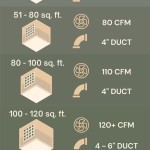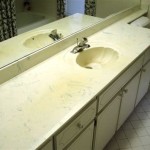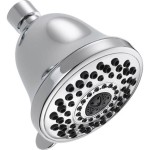How To Fit Lino In A Small Bathroom
Fitting linoleum, often referred to simply as "lino," in a small bathroom can be a cost-effective and relatively straightforward way to update the space. While professional installation is always an option, a confident DIY enthusiast can typically achieve satisfactory results with careful planning, precise measurements, and methodical execution. This article provides a comprehensive guide to installing lino in a small bathroom, covering everything from preparation to final finishing touches.
Before embarking on the installation process, it is crucial to understand the inherent challenges of working in a confined space like a small bathroom. Maneuvering large sheets of lino can be difficult, and precise cuts are essential to ensure a clean and professional finish. Thorough preparation and meticulous attention to detail are paramount for a successful installation.
Key Point 1: Preparing the Bathroom and Measuring Accurately
The initial stage of any flooring installation is preparation. This involves removing all fixtures from the bathroom where possible. Toilets, sinks, and vanities often present obstructions that complicate the laying process. If removing these items is not feasible, protect them thoroughly with drop cloths and masking tape. Disconnect the toilet from the water supply and carefully remove it. The sink can sometimes be left in place if it is wall-mounted, but be sure to protect its surface. Consider removing the bathroom door to allow for easier access and prevent damage during the installation process.
Next, remove the existing flooring. This might involve lifting old tiles, pulling up old vinyl, or removing carpet. Use appropriate tools such as a scraper, pry bar, and utility knife to dismantle the old flooring without damaging the subfloor. Once the old flooring is removed, thoroughly clean the subfloor. Sweep up any debris, vacuum the surface, and then wash it with a suitable cleaning solution to remove dirt, grease, and grime. Allow the subfloor to dry completely before proceeding further.
Inspecting the subfloor is crucial. Look for signs of damage such as cracks, holes, or unevenness. Repair any imperfections using a floor leveling compound. This compound fills in low spots and creates a smooth, even surface for the lino to adhere to. Apply the leveling compound according to the manufacturer's instructions and allow it to dry and cure fully before proceeding.
With the subfloor prepared, accurate measurement is the next crucial step. Use a measuring tape to determine the length and width of the bathroom at its widest points. Draw a detailed sketch of the bathroom, noting the positions of any fixtures, pipes, or doorways. Transfer these measurements onto the lino, adding a few extra inches to each side for trimming and adjustments. Remember, it is always better to have slightly too much lino than not enough. Consider the placement of the lino pattern when planning your cuts, ensuring that the pattern aligns appropriately within the room.
Prior to cutting, unroll the lino in a large, flat area, preferably outside the bathroom, and allow it to acclimatize to the room temperature for at least 24 hours. This helps the material relax and prevents it from shrinking or expanding after installation. Laying the lino flat also makes it easier to work with and prevents creases or folds from forming.
Key Point 2: Cutting and Fitting the Lino
With the measurements transferred and the lino acclimatized, the cutting process can begin. Use a sharp utility knife with a fresh blade. A dull blade will tear the lino and create jagged edges. Place the lino on a cutting surface, such as a piece of plywood or a cutting mat, to protect the underlying floor. Follow the marked lines carefully, using a straight edge as a guide for long, straight cuts. For curved or irregular shapes, use a flexible measuring tape or a template to trace the shape onto the lino.
When cutting around pipes, toilets, or other fixtures, make relief cuts extending from the edge of the lino to the point where the fixture will be positioned. This allows the lino to lay flat around the fixture without buckling or creasing. Start with small cuts and gradually enlarge them until the lino fits snugly around the fixture. It is essential to prioritize precision during this stage to achieve a professional-looking finish. Patience and a steady hand are critical.
After cutting the lino to size, conduct a dry fit within the bathroom. Carefully position the lino in place, aligning it with the walls and fixtures. Check for any gaps or overlaps and make any necessary adjustments. This dry fit allows you to identify potential problems before applying adhesive. Mark any areas that require further trimming or adjustments. Pay particular attention to corners and doorways, as these areas often require the most precise cuts.
Once satisfied with the fit, roll back half of the lino and apply adhesive to the subfloor. Use a notched trowel to spread the adhesive evenly across the surface, following the manufacturer's instructions regarding the type of adhesive and the trowel notch size. Allow the adhesive to tack up for the recommended amount of time before laying the lino back down. Carefully smooth the lino over the adhesive, working from the center outwards to eliminate air bubbles and ensure good contact with the subfloor. Use a floor roller to apply even pressure and ensure a strong bond between the lino and the adhesive.
Repeat the process for the other half of the lino, ensuring that the edges align properly. Use a damp cloth to wipe away any excess adhesive that may squeeze out from the edges. Allow the adhesive to cure for the recommended time before proceeding with the final steps.
Key Point 3: Finishing Touches and Sealing
After the adhesive has cured, the final stage involves trimming the excess lino and sealing the edges. Use a sharp utility knife to trim away any excess lino along the walls and around fixtures. Ensure that the cuts are clean and straight, following the contours of the walls and fixtures. A metal ruler or straight edge can be helpful for achieving precise cuts. Be careful not to damage the walls or fixtures during the trimming process.
Sealing the edges of the lino is essential to prevent water from seeping underneath and damaging the subfloor. Apply a bead of sealant along the perimeter of the room, where the lino meets the walls and fixtures. Use a sealant gun to apply the sealant evenly and smoothly. Wipe away any excess sealant with a damp cloth. Choose a sealant that is specifically designed for use with vinyl flooring and that is resistant to mold and mildew. Allow the sealant to cure completely before exposing the floor to water.
Once the sealant has cured, install baseboards or skirting boards around the perimeter of the room. These provide a finished look and protect the walls from damage. Attach the baseboards using nails or adhesive, ensuring that they are securely fastened to the wall. Caulk any gaps between the baseboards and the walls to create a seamless finish. Touch up any paint or trim as needed to complete the installation.
Reinstall the toilet and other fixtures, ensuring that they are properly sealed to prevent leaks. Reconnect the water supply and test the toilet to ensure that it is functioning correctly. Clean the lino flooring with a mild detergent and water to remove any dirt or debris. Avoid using harsh chemicals or abrasive cleaners, as these can damage the surface of the lino. Allow the floor to dry completely before using the bathroom.
Properly installed and maintained lino flooring can provide years of durable and attractive service in a small bathroom. Regular cleaning and maintenance will help to prolong its lifespan and keep it looking its best. Avoid dragging heavy objects across the floor, as this can scratch or damage the surface. Use mats or rugs in high-traffic areas to protect the flooring from wear and tear. By following these guidelines, you can enjoy a beautiful and functional bathroom floor for many years to come.

Diy How To Lay Vinyl Or Lino Flooring

How To Lay Vinyl Floor In A Bathroom Dove Cottage

How To Install Sheet Vinyl Floor Decor Adventures

How To Lay Vinyl Floor In A Bathroom Dove Cottage

How To Lay Vinyl Floor In A Bathroom Dove Cottage

How To Fit Vinyl Flooring In A Bathroom Turning House Into Home

Diy How To Lay Vinyl Or Lino Flooring

How To Install Vinyl Sheet Flooring A Erfly House

How To Install Vinyl Plank Flooring In A Bathroom Fixthisbuildthat

Vinyl Planks In Bathrooms Residential Inspiration Flooring
Related Posts







